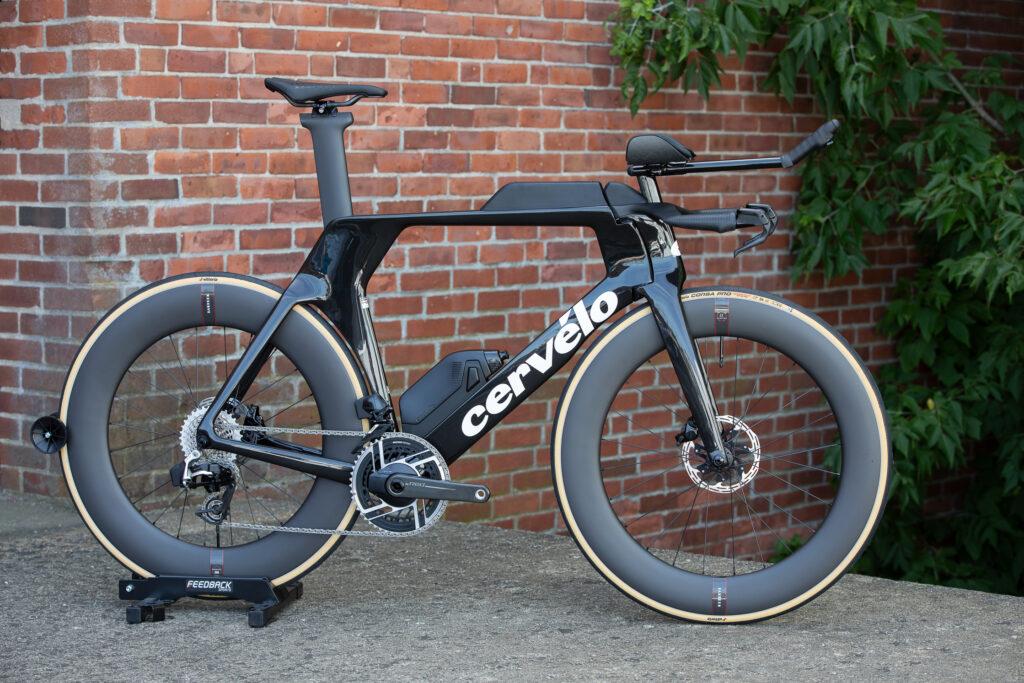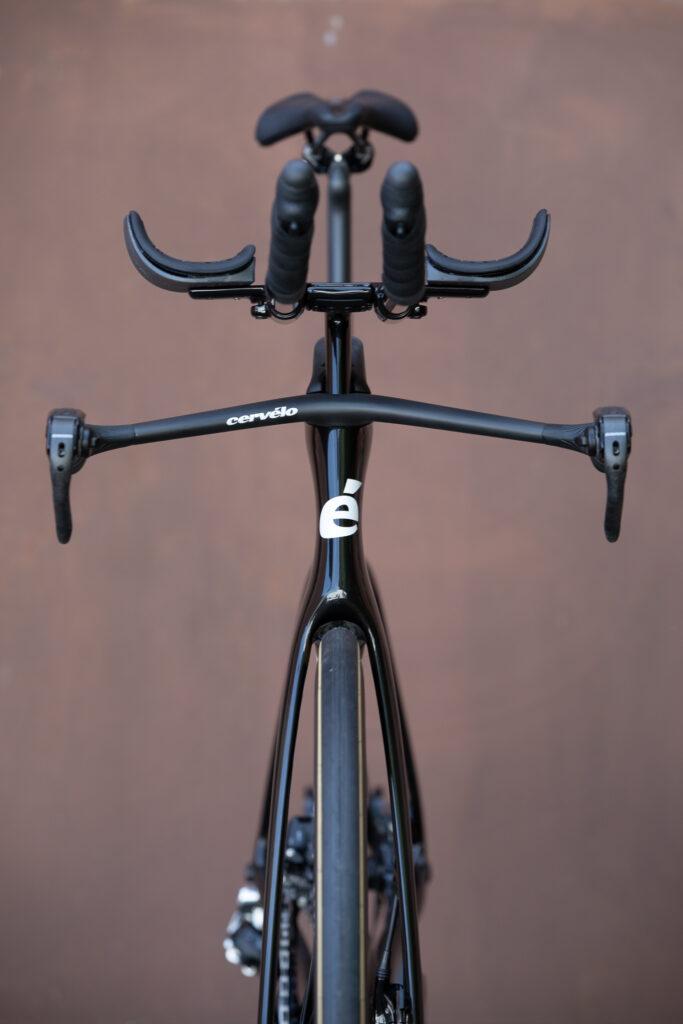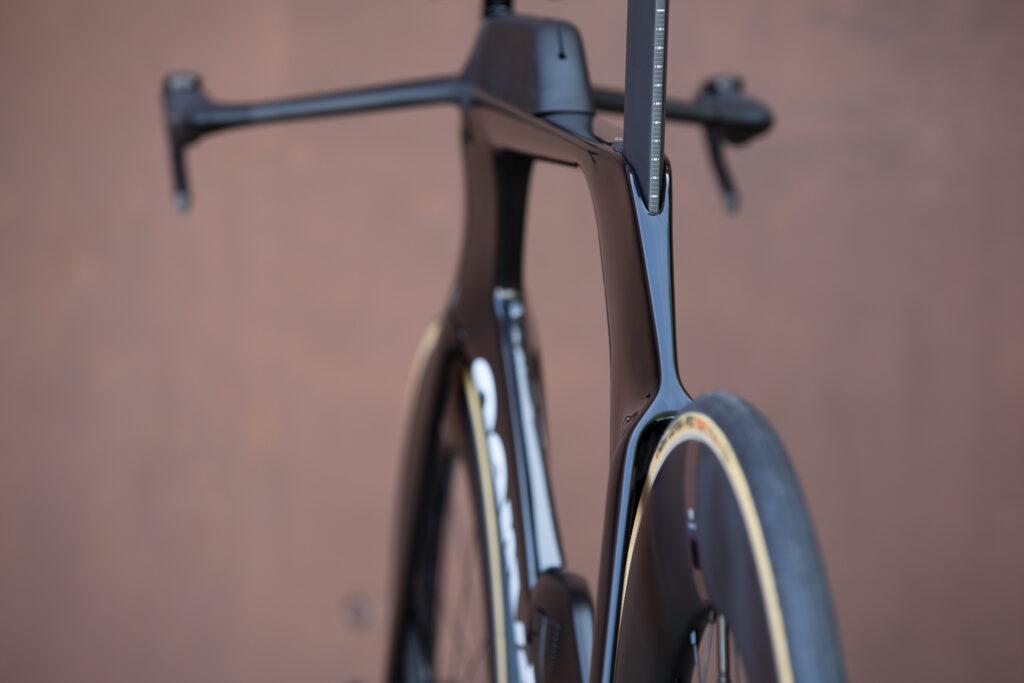Cervelo’s New P5 Review and Thoughts

Cervelo has been the industry leader in the engineering and aerodynamic design of bikes since they first showed up in triathlon in the mid-nineties. Cervelo designed the flagship P5 to be the fastest bike possible. After five years without change, they found enough details to improve upon that they released the newest 2025 version. While many have commented the bike looks more elegant and appealing to the eye, I will focus on the most important details that will matter the most to performance. The 2025 Cervelo P5 now fits a wider range of riders, has clearance for larger wheel/tire combinations, and is even lighter. Let’s look under the hood at these improvements and what they mean to the end user – the triathlete or time trialist riding them.
’25 Cervelo P5 Fitting Improvements
Higher Basebar Adjustment Range
The updated aerobar system on the new P5 opens the fitting window to accommodate a wider range of riders. The basebar can now stack 40mm higher. Thankfully, this also allows the aerobars to adjust higher. While the improvement in the adjustment window offers more flexibility for higher aerobar positions, the higher basebar position could be most noticeable and appreciated by triathletes.
My personal experience is that the P5 is second to none in how easily it corners, which is enhanced with a lower basebar position. However, a lower basebar position puts more weight on your hands when out of the aerobars and is simply not always that comfortable when cornering, climbing, or simply choosing to ride sitting up on training rides. While staying in the aerobars as much as possible is always a great goal, being able to increase the height of the basebar on the ’25 Cervelo P5 is a practical improvement for many riders. Personally, I’ve noticed that it is far less comfortable warming up on a low basebar than it is on road bike hoods; many mornings I’m simply not ready to climb right into the aerobars as soon as I start pedaling… Related, some triathletes change the height of their basebars and aerobars in training compared to racing. It’s good to see Cervelo respond to this need and allow for the basebar to be raised with ease on this bike without giving up anything in the process.
Aerobar Pad Adjustment
The aerobar pads on the ’25 Cervelo P5 are longer and larger than the prior generation and they offer more fore and aft adjustment. While there are 3rd party aerobar pads which allowed for this on the last P5, it’s nice when the bike comes out of the box without the need for add-on attachments.
The aerobar pads can be set up significantly more rearward than the last generation P5. This resolves a key area that made the fit on the prior generation P5 difficult for some. Simultaneously, if you are interested in 3rd party pads or extensions the new P5 accommodates many. In my experience, this ability to accommodate a range of aftermarket bar accessories is rare for a top-of-the-line integrated-front-end triathlon/TT bike.
I’ve personally found through aero testing that the Cervelo aerobar is faster than some of the aerobar “upgrades” I’ve tried on my P5. While I’m keeping the Cervelo bar, it’s nice to know the bike can handle other options and future upgrades that may improve it for some riders.


’25 Cervelo P5 Aerobar Extension Angle
Aerobar extension angle is a key component to bike fit and building the most comfortable and fast position for riders. Thankfully, the new ’25 Cervelo P5 can adjust the extension angle from 0 degrees to 30 degrees in 5-degree increments. More angle is not necessarily better, but the last P5 only went from 0 to 15 degrees. This was not enough for all riders. I’ve found the extension angle system Crevelo designed to be remarkably easy to change compared to some other options. You are just a 4mm hex wrench away from loosening two bolts, rotating the extensions on top of the riser, and then clamping it back down.
Wheel/Tire Clearance on the ’25 Cervelo P5
The new Cervelo P5 accepts up to 34mm wide (measured) tires. Those of us who have been around for a while know that you can take the fastest tire and put it on the fastest wheel and you will not necessarily have the fastest combination. Likewise, you can take the fastest wheel/tire combination and put it in the fastest frame and not necessarily have the fastest bike. This principle has been around since aero frames started to show up in the industry – does anyone else remember how fast the original Hed Trispoke wheel was until you put a 23mm tire on it instead of a 20mm?
Tire and wheel expectations for aero bikes in ’24 are quite different from ’04; many bikes can now accommodate larger tires which are faster smoother and corner better. However, what sets the ’25 Cervelo P5 apart is that it is designed to work best with larger tires and wider wheels. This is demonstrated in the aerodynamics of the ’25 Cervelo P5 bike system.
’25 Cervelo P5 Aerodynamics and Watt Savings
Cervelo claims the ’25 P5 frame itself only saves about 1 watt over the last ’19 P5 frame. These top aero bikes are already so fast, that it’s nice to see a long-time industry leader in aerodynamics make a claim that shows that anybody making massive aero promises at this point should be questioned – at least when it comes to the frame. However, when the new Reserve 77/88 wheels with Vittoria 29mm tires are run in the ’25 Cervelo P5 the whole bike/wheel system is 5 watts faster than the prior model. While 5 watts may not get existing P5 users to upgrade to the ’25 model, given how much prototyping and design went into this bike over the last five years, the number is believable. Anybody investing in a ’25 Cervelo P5 with the Reserve 77/88 wheels can rest assured that the wheels that ship with the bike are aerodynamically fast and optimized to work great with the frame. Likewise, if you want to save as many watts as possible, you need to be paying attention to the system as a whole and look at the wheels and tires in relation to the frame.
Are there drawbacks to the new Cervelo P5?
If a bike doesn’t fit you well, that’s the biggest drawback of them all. This is part of why taking a fit first/rider matched approach to finding a well-suited bike is so important. While this is no fault of the bike, get fit first before buying a new P5, and make sure that where you buy the bike from builds it to match your fit numbers. This is the approach we have built almost 25 years of history at Fit Werx and remains the most important variable when it comes to performance and comfort on your new bike.
The P5’s aerobars handle most of the leading between the arms hydration systems and a long-course triathlete will run a one or two-bottle system behind the saddle. The ’25 Cervelo P5 does not have the internal bladder hydration or storage options that we saw on some tri bikes of the last generation from other manufacturers. While I’ve worked with some triathletes who preferred internal hydration, many others found it cumbersome to clean and use. It also made the bikes heavier.
The price tag of $13,500 for the Red AXS or Dura-Ace Di2 build on the Cervelo P5 is among the industry leaders when it comes to how much bike you get for your dollar. Likewise, there are also Force and Ultegra Di2 versions of the bike at $10,000. However, the P5 is not an entry-level bike. If your budget is under $10k then the Cervelo P5 is not an option.
Is the P5 the triathlon bike you’ve been waiting for? If you’ve been waiting for the next generation of superbike from the industry’s long-time leader in engineering and aerodynamic design, then you’ll appreciate the changes Cervelo made and be quite happy with this bike. Cervelo is planning to start delivery of the ’25 P5 in September of 2024, so there is no better time than now to have your fitting updated and see how it matches up to your position. Contact us today to schedule and/or learn more.
